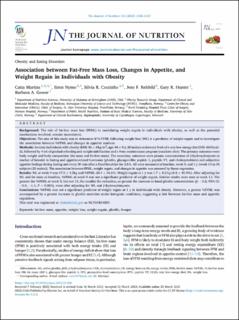| dc.contributor.author | Alho Letra Martins, Catia Patricia | |
| dc.contributor.author | Nymo, Siren | |
| dc.contributor.author | Coutinho, Sílvia | |
| dc.contributor.author | Rehfeld, Jens F. | |
| dc.contributor.author | Hunter, Gary R. | |
| dc.contributor.author | Gower, Barbara A. | |
| dc.date.accessioned | 2024-02-05T14:07:23Z | |
| dc.date.available | 2024-02-05T14:07:23Z | |
| dc.date.created | 2023-04-28T10:45:45Z | |
| dc.date.issued | 2023 | |
| dc.identifier.citation | Journal of Nutrition. 2023, 153 (5), 1330-1337. | en_US |
| dc.identifier.issn | 0022-3166 | |
| dc.identifier.uri | https://hdl.handle.net/11250/3115672 | |
| dc.description.abstract | Background
The role of fat-free mass loss (FFML) in modulating weight regain in individuals with obesity, as well as the potential mechanisms involved, remain inconsistent.
Objectives
The aim of this study was to determine if % FFML following weight loss (WL) is a predictor of weight regain and to investigate the association between %FFML and changes in appetite markers.
Methods
Seventy individuals with obesity (BMI: 36 ± 4 kg/m2; age: 44 ± 9 y; 29 males) underwent 8 wk of a very low energy diet (550–660 kcal/d), followed by 4 wk of gradual refeeding and weight stabilization and a 9-mo maintenance program (eucaloric diet). The primary outcomes were body weight and body composition (fat mass and fat-free mass). The secondary outcomes were plasma concentrations of β-hydroxybutyrate (a marker of ketosis) in fasting and appetite-related hormones (ghrelin, glucagon-like peptide 1, peptide YY, and cholecystokinin) and subjective appetite feelings during fasting and every 30 min after a fixed breakfast for 2.5 h. All were measured at baseline, week 9, and 1 y [week 13 in 35 subjects (25 males)]. The association between FFML, weight regain, and changes in appetite was assessed by linear regression.
Results
WL at week 9 was 17.5 ± 4.3kg and %FFML 20.4 ± 10.6%. Weight regain at 1 y was 1.7 ± 8.2 kg (8.8 ± 45.0%). After adjusting for WL and fat mass at baseline, %FFML at week 9 was not a significant predictor of weight regain. Similar results were seen at week 13. The greater the %FFML at week 9, but not 13, the smaller the reduction, or greater the increase in basal ghrelin concentration (β: −3.2; 95% CI: −5.0, −1.1; P = 0.003), even after adjusting for WL and β-hydroxybutyrate.
Conclusions
%FFML was not a significant predictor of weight regain at 1 y in individuals with obesity. However, a greater %FFML was accompanied by a greater increase in ghrelin secretion under ketogenic conditions, suggesting a link between fat-free mass and appetite regulation. | en_US |
| dc.language.iso | eng | en_US |
| dc.publisher | Elsevier | en_US |
| dc.rights | Navngivelse 4.0 Internasjonal | * |
| dc.rights.uri | http://creativecommons.org/licenses/by/4.0/deed.no | * |
| dc.title | Association between Fat-Free Mass Loss, Changes in Appetite, and Weight Regain in Individuals with Obesity | en_US |
| dc.title.alternative | Association between Fat-Free Mass Loss, Changes in Appetite, and Weight Regain in Individuals with Obesity | en_US |
| dc.type | Peer reviewed | en_US |
| dc.type | Journal article | en_US |
| dc.description.version | publishedVersion | en_US |
| dc.source.pagenumber | 1330-1337 | en_US |
| dc.source.volume | 153 | en_US |
| dc.source.journal | Journal of Nutrition | en_US |
| dc.source.issue | 5 | en_US |
| dc.identifier.doi | 10.1016/j.tjnut.2023.03.026 | |
| dc.identifier.cristin | 2144106 | |
| cristin.ispublished | true | |
| cristin.fulltext | original | |
| cristin.qualitycode | 2 | |

